We spent an incredible 8 days on safari in northern Tanzania in October of 2024. This truly was an epic adventure! I have gone on safari in South Africa, Botswana, and Kenya in the past and they were all great. Tanzania was something extra special though. I never expected to have so many incredible wildlife sightings, one after another, during this trip. The Serengeti was especially magical and is my new favorite safari destination.
Our safari included Tarangire National Park, Lake Manyara National Park, Serengeti National Park, and the Ngorongoro Crater all in about a week. We traveled with the company Safari 360. They did a great job organizing and executing our Tanzania safari. Below is our itinerary followed by a description of our experience and some photos to help you see how amazing this trip was.
Itinerary
- Day 1: Tarangire National Park
- Day 2: Lake Manyara National Park / Central Serengeti
- Day 3: Central Serengeti
- Day 4: Northern Serengeti
- Day 5: Central Serengeti
- Day 6: Southern Serengeti
- Day 7: Ngorongoro Crater
- Day 8: Return drive to the city of Arusha
Day 1: Tarangire National Park
Our first day of our 8 day safari trip was spent at Tarangire National Park. We were picked up at our hotel in Arusha by our coffee-loving guide, Yoah at 8 a.m. We stopped on the way for him to get his coffee fix while we glanced at some safari gift shops, then headed on to Tarangire.
As we made our way along the tarmac, we passed Maasai herding their cows and goats. Nearing the park, we turned onto the dustiest gravel road ever (or so I thought at the time). Since our vehicle had no air conditioning, the windows were open, the dust challenging each breath. At 10:30 a.m. we arrived and our first safari began.
Tarangire National Park is known for having many elephants and baobab trees. We saw the baobab trees right away but only found elephants after a few hours. The wildlife was abundant here, never going long between sightings. We found multiple lions, a few herds of elephants, a few giraffes, and some vervet monkeys and baboons. We also saw a bunch of zebra, wildebeest, water buffalo, and impalas.

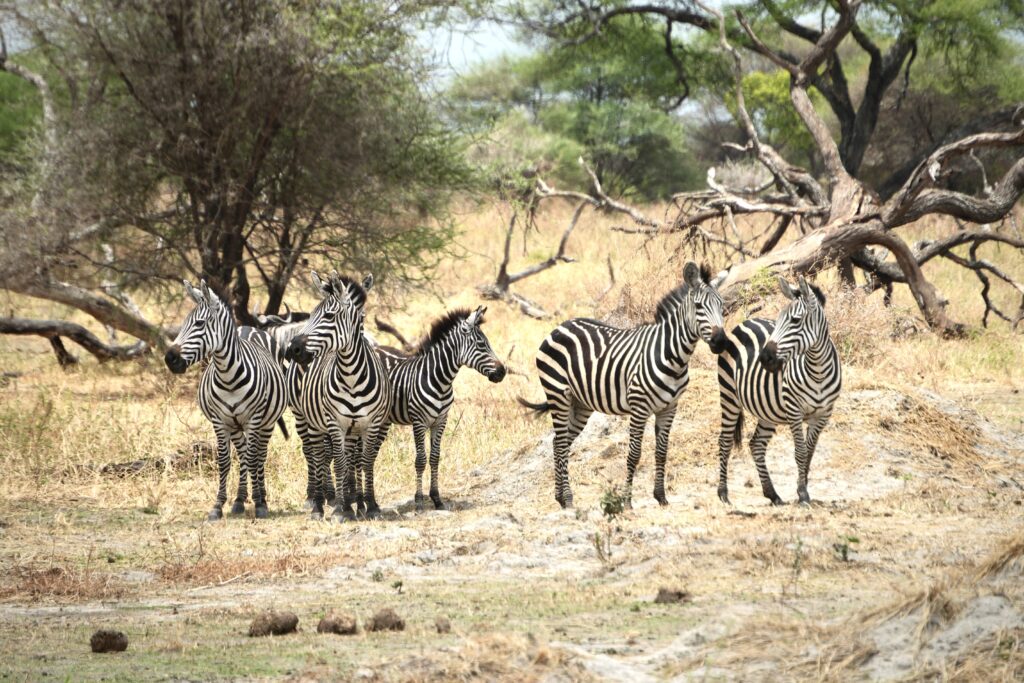

Tarangire is densely packed with animals as well as tourists in their safari vehicles. It was great for seeing lots of animals in a short period but it did have a bit of a “driving through a zoo” feel to it. We really enjoyed our time here, but I personally think it lacks in comparison to areas we go to in following days. We left the park around 3:15 p.m. and drove to our tented camp on Lake Manyara called Africa Safari Lake Manyara.

African Safari Lake Manyara was really nice. Our room was super spacious with a nice shower and comfortable bed. They even had a nice pool with a view out to Lake Manyara to take a refreshing dip in. The lodge is located on the banks of the lake, but since the lake has increased in size the last couple of years, the grounds are now flooding. Some of the rooms were no longer able to be used and they had to move their dining area to a makeshift tent. My favorite things about this tented camp were the pool, all the vervet monkeys running around and playing on the grounds, and their excellent food.


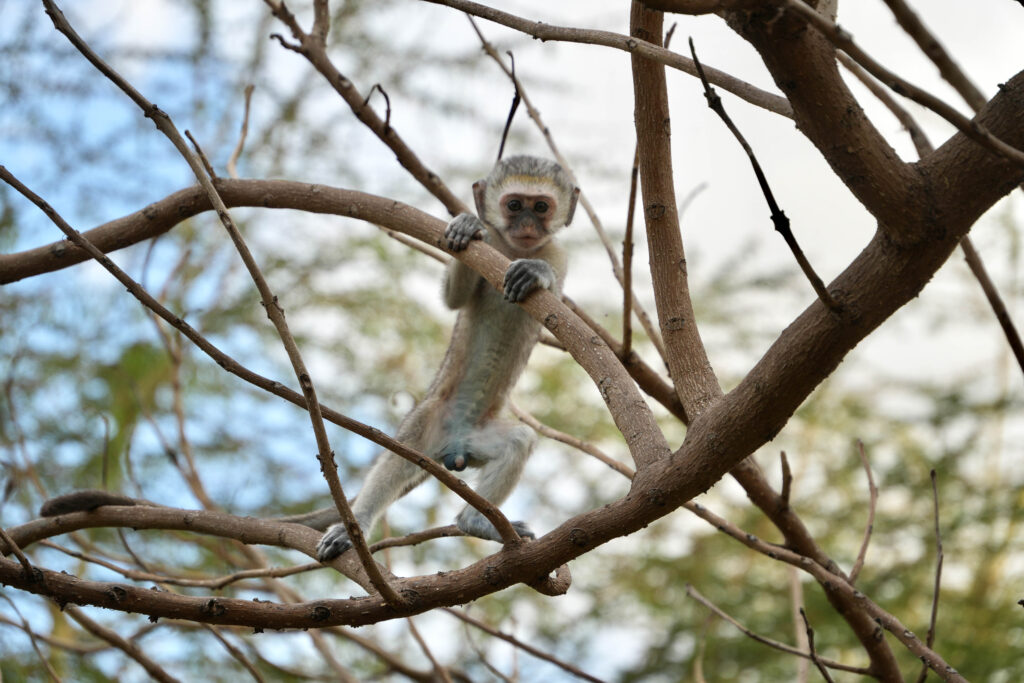
Day 2: Lake Manyara National Park
Lake Manyara National Park is a forest along the banks of Lake Manyara just outside of a small town. We drove into the park when it opened at 8:30 a.m. The roads through the park guide you under a thick canopy of trees. Shortly upon entering the forest we started spotting monkeys. We saw many large troops of baboons crossing the road and playing in the treetops. We saw blue monkeys running through the branches. There were also vervet monkeys, but we only saw a couple of them. Monkeys are usually the most common sighting in this park.
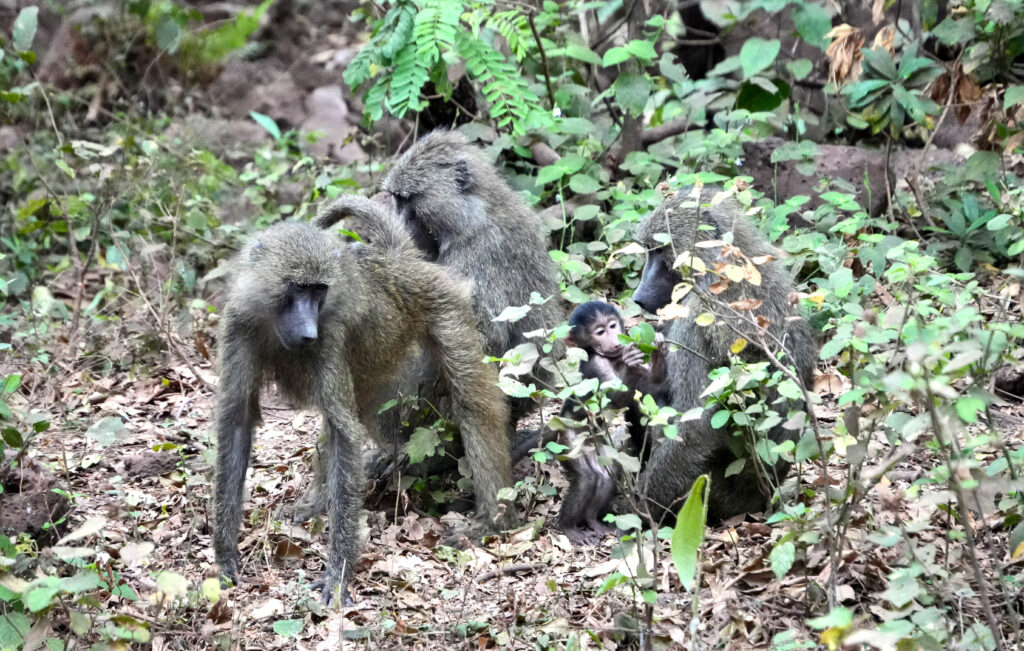
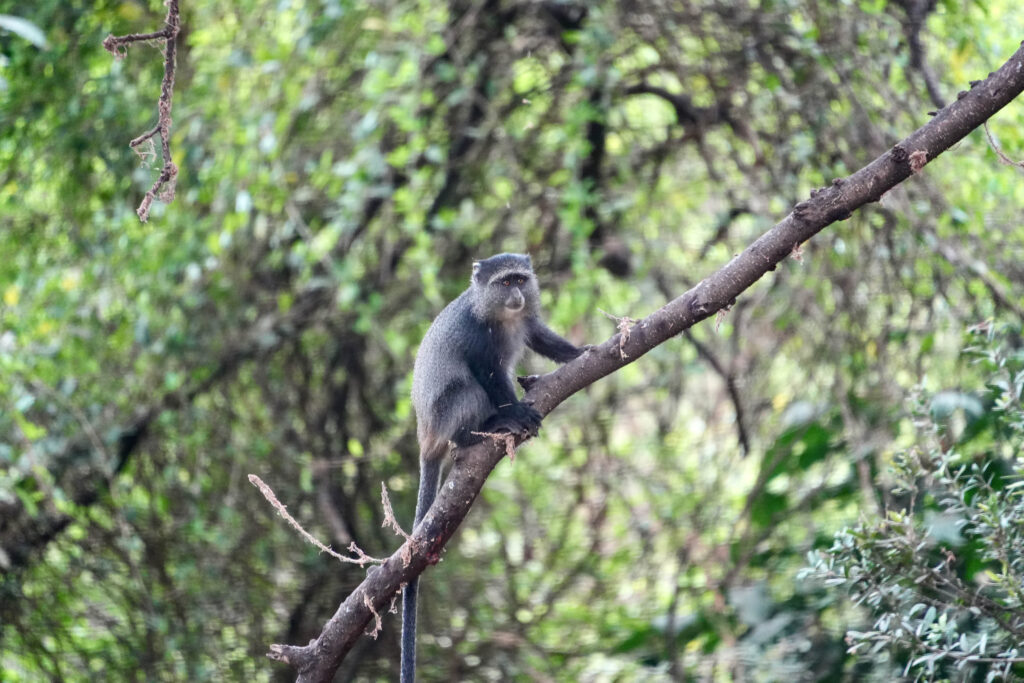
We spent about 2 1/2 hours in the park. Most of the time was just spent enjoying the ride through the forest. We did find a few other animals including a few hippopotamus in the lake, a water buffalo relaxing next to the water, a group of impalas, and a few silver-cheeked hornbills.
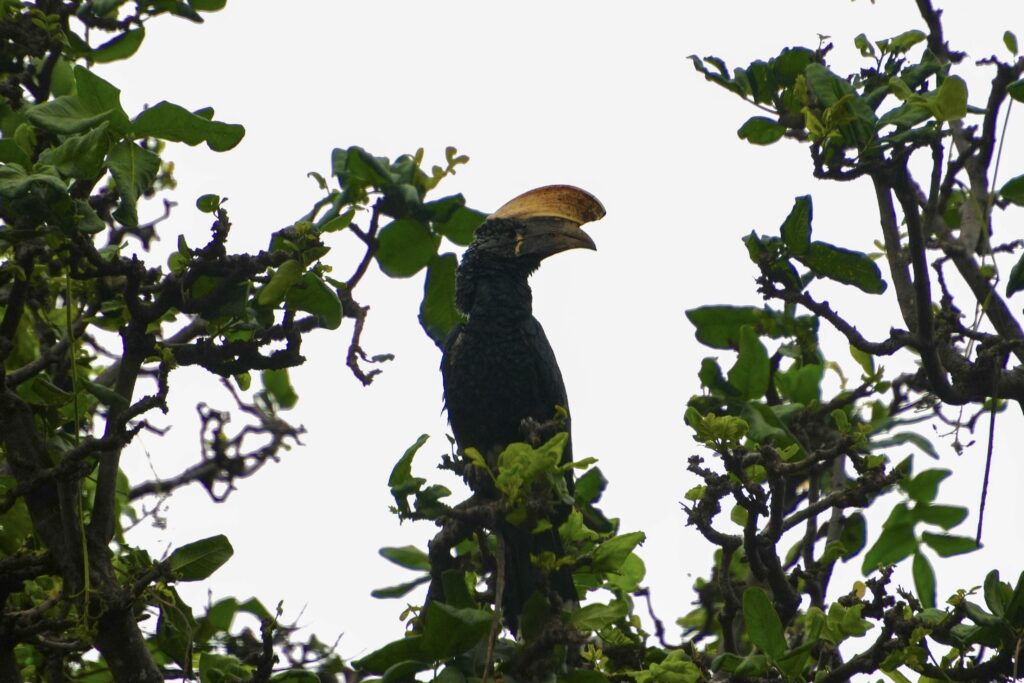
If you are only able to spend a few days on safari, you may not want to pick this park as part of your itinerary as you will likely not see a large variety of animals. If you are on a longer safari trip, however, this park is a nice addition. I really loved seeing all the monkeys. We found our ride through the forest very relaxing and enjoyable and are glad we had included it in our itinerary.
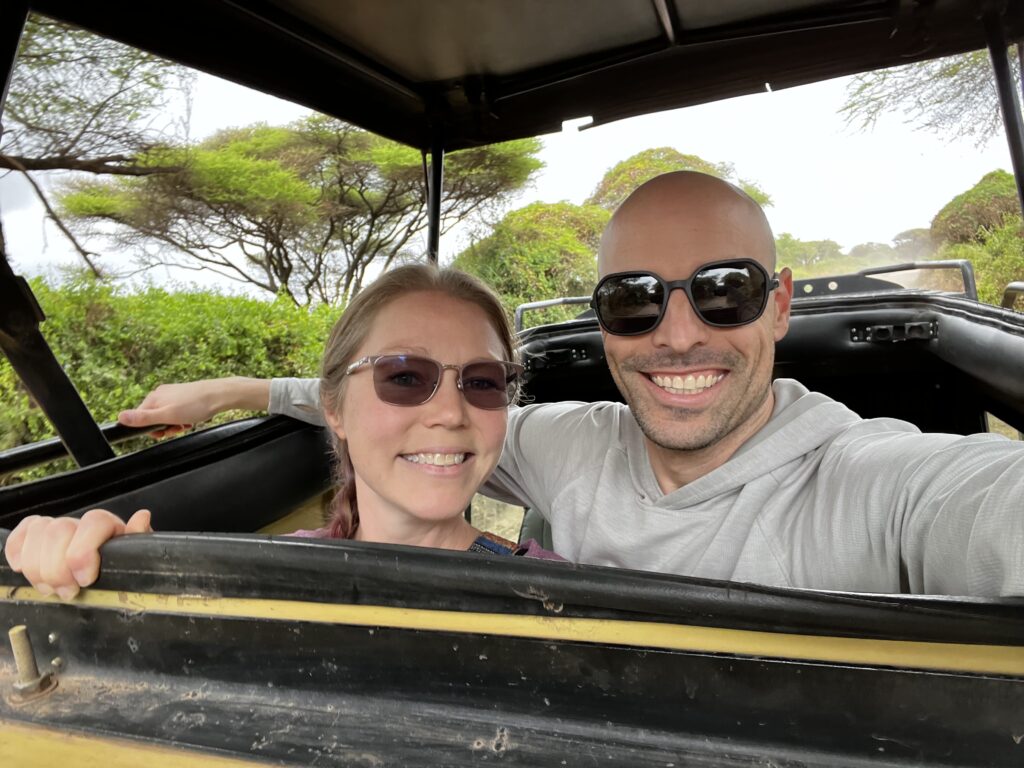

We exited the park at 11 a.m. and started the long drive to Serengeti National Park. To reach the Serengeti by road, you will need to pass through the Ngorongoro Conservation Area. Unfortunately the roads from the gate of the Ngorongoro Conservation Area all the way to the Serengeti are not paved. The washboard road almost shakes you out of your seat as you are being covered in dust. Just riding along in the vehicle is exhausting.
The highlight for this section of the transit is a view spot looking over and into the crater. More on the Ngorongoro Crater later. We saved going down into the crater for our drive back at the end of our safari trip. The drive along this road takes you past Maasai villages with round housing structures within the conservation area. Maasai men herd their cattle across the roads while the children are watching over flocks of goats.

We started to see a few zebra on the grasslands and we were excited to see a giraffe grazing on a thistly tree right next to the road. Finally we came to the old gate of the Serengeti and took a photo. We ended up delayed here for about 30 minutes because a strap holding one of the fuel tanks on our vehicle broke and the tank was hanging down on one side. A fix was devised with some string to hold the fuel tank in place. This got us back on the road where shortly thereafter we passed through the current official gate and into the Central Serengeti.

Day 2 Part 2: Serengeti National Park
The word Serengeti means “endless plains” and that is how it looks in the central eastern part of the park. Right away upon entering the Serengeti, we started seeing lots of animals. As we were trying to make it to camp for the night, we kept stumbling across incredible sightings. We saw a lion sitting right next to the road, not a care in the world about all the safari vehicles passing right next to her. We came across two calm elephants, one of which walked up so close to our vehicle I started to think she might touch me!

A nearby giraffe had a bunch of oxpecker birds clinging to its face and neck. They were picking parasites off the the giraffe with their bright orange beaks. As the last rays of sunlight were disappearing for the night, we even found a lion sleeping in a tree before we made it to camp.

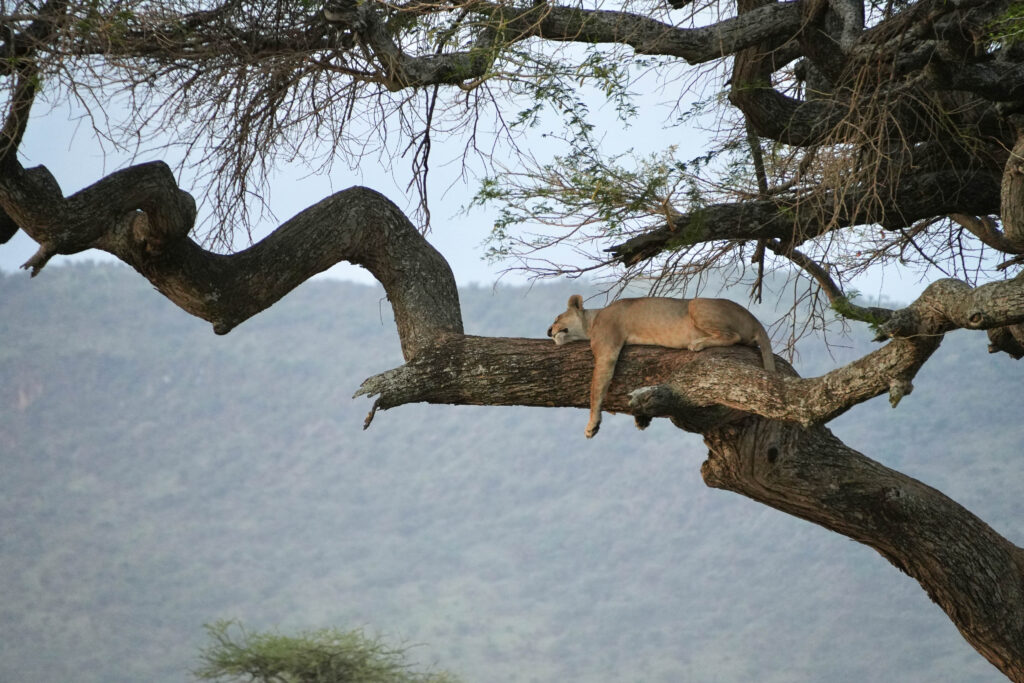
Day 3: Central Serengeti
Wow! The Serengeti really is amazing. We spent the morning doing a game drive in the Central Serengeti and saw an incredible number of different animals! We saw wildebeest, zebra, water buffalo, giraffes, elephants, a large male lion, impala, many hippos, warthogs, ostrich, and a very distant cheetah. We even found a leopard in a tree. Leopards are one of the more challenging animals to find on safari as they are shy and nocturnal, but we were lucky enough to see multiple during this trip.


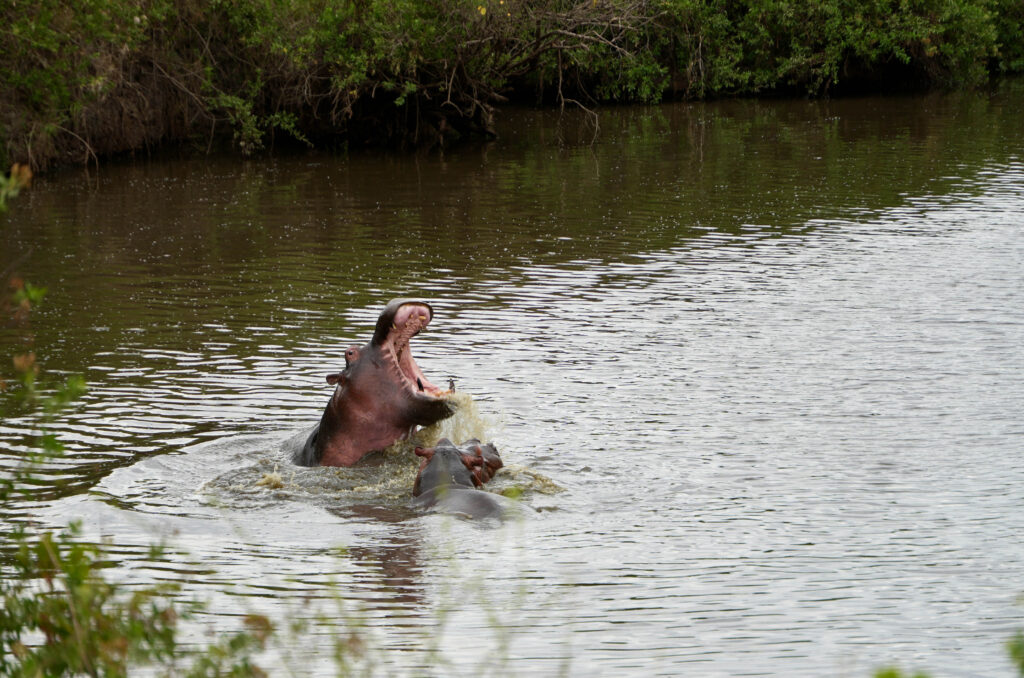
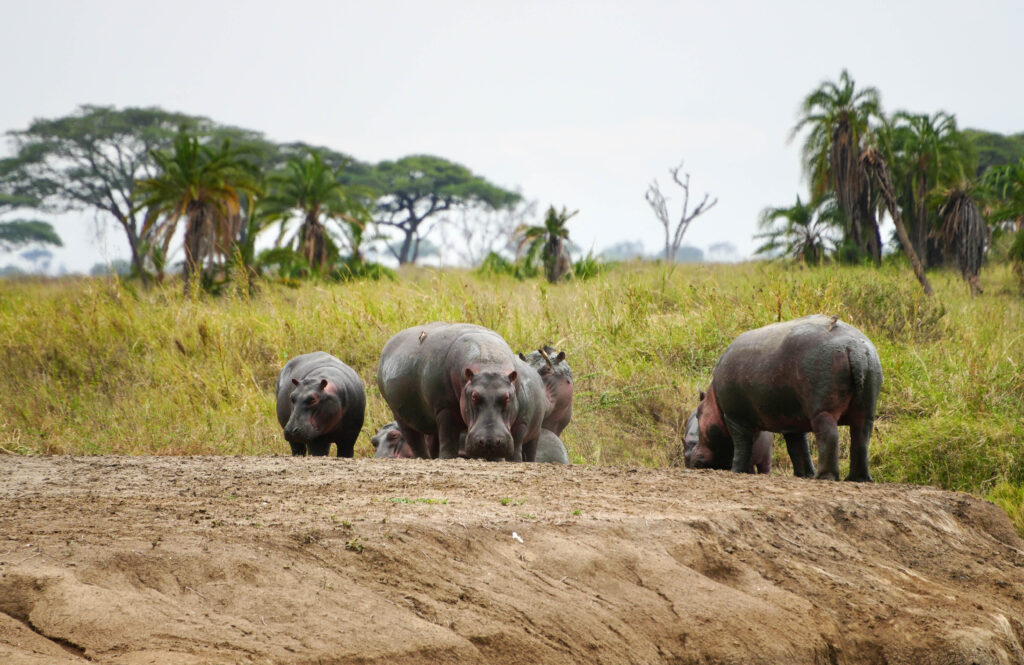
A memorable experience was an interaction between a pride of lions and a herd of elephants. The lions were resting in the brush under a tree near a small pond. They were mostly hidden, but we heard a warthog screeching and they all perked up, letting us get a good view of them. After watching them for a while, a large herd of elephants came towards us. Two of these elephants walked over to drink from the small pond. The lions got nervous, and the elephant took note of them. The lions tried to slink away into the thick brush but not quickly or far enough away. The elephants flared their ears, trumpeted and stomped towards the lions chasing them off.
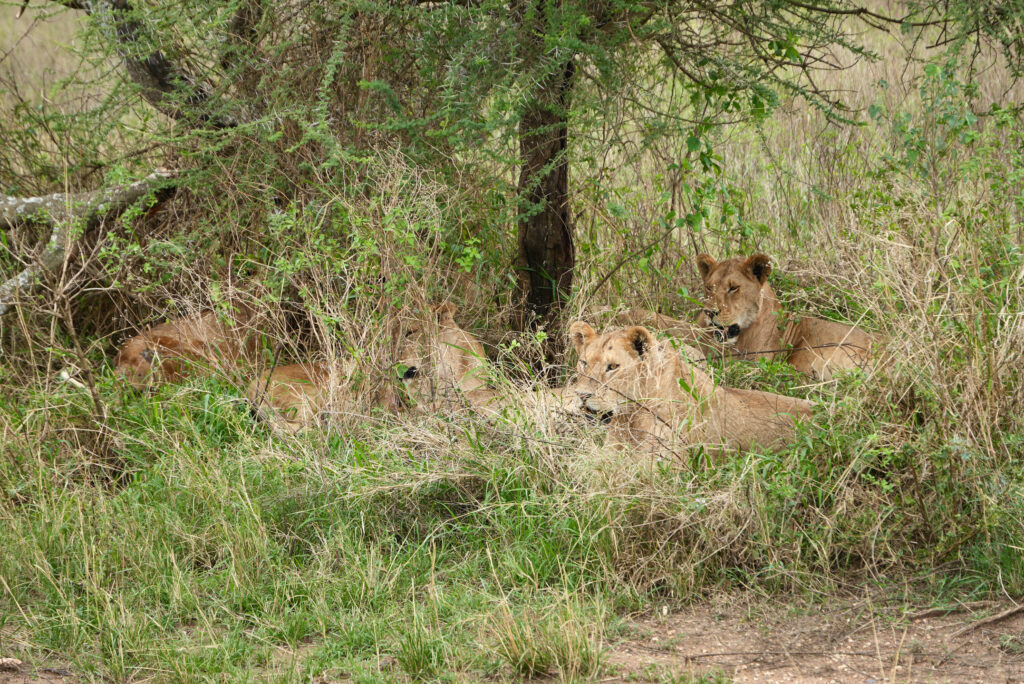
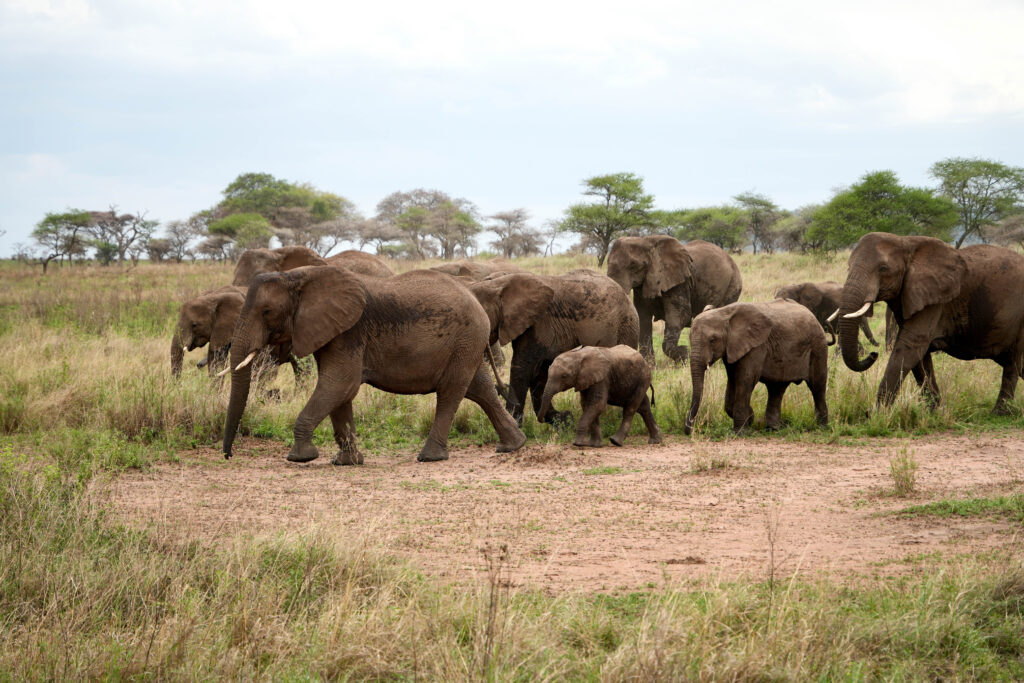
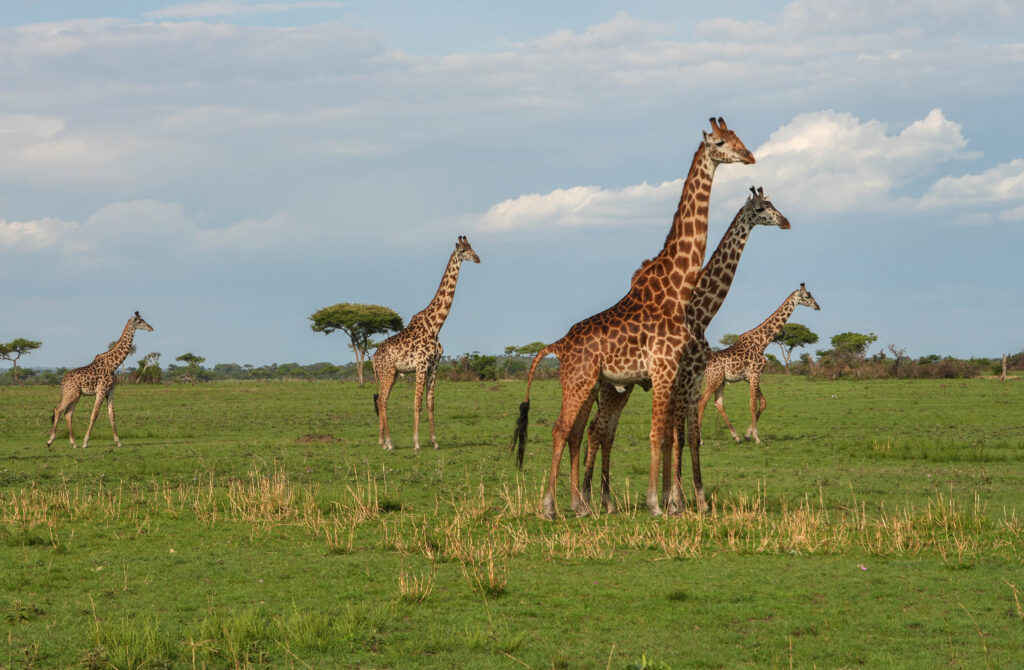
In the afternoon we drove a few hours up to the northern Serengeti so we could visit the Mara River the next morning.
Day 4: Northern Serengeti
The landscape in the Northern Serengeti has rolling hills dotted with large rocks in contrast to the expansive plains in the Central Serengeti. There are lots of wildebeest and zebra here during this time of year.
The top thing to do in the Northern Serengeti is to visit the Mara River and hope to see the wildebeest migration. The Mara River is the natural boundary between the Serengeti in Tanzania and the Masai Mara in Kenya. Each July/August the wildebeest cross the river from the Serengeti to the Masai Mara to feed on the abundant grass that has grown in Kenya. This is during the dry season in Tanzania when the grass there is sparse. By October the rains are slowly starting again in Tanzania and grazing improves. We were told that this is when the wildebeest cross back to the Serengeti, and luckily we were here for it.
The river crossings are a real danger for the wildebeest. They can fall as they frantically stampede down the banks to the water, they can crush each other, or drown on the swim. There is also the threat of hungry crocodiles who may be hiding, unseen in the water.
As a tourist hoping to catch the exciting river crossing, you may be waiting a long time. The wildebeest move back and forth along the banks of the river for long periods, waiting for a brave leader to pick a good area to cross and go for it. Once that happens, they all start running down the banks and into the water. Each is hoping they are not the unlucky one to get caught by a crocodile.
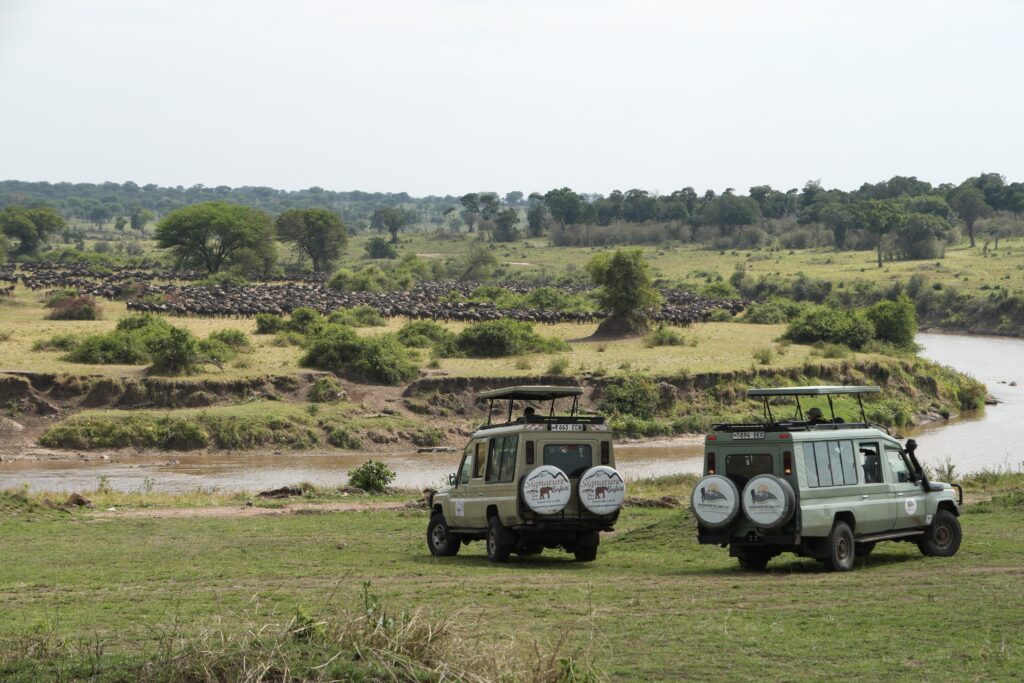
We were super lucky and soon after arriving to the river, some wildebeest headed down the banks to the water ready to cross. This first group got scared though and reversed back up to the safety of the cliffs above. Shortly thereafter, they chose another area and followed through. As soon as they began to cross, all the safari vehicles rushed to viewing areas and we watched as hundreds of wildebeest made their way across. Lucky for this group, no crocodiles were to be found. Wow!
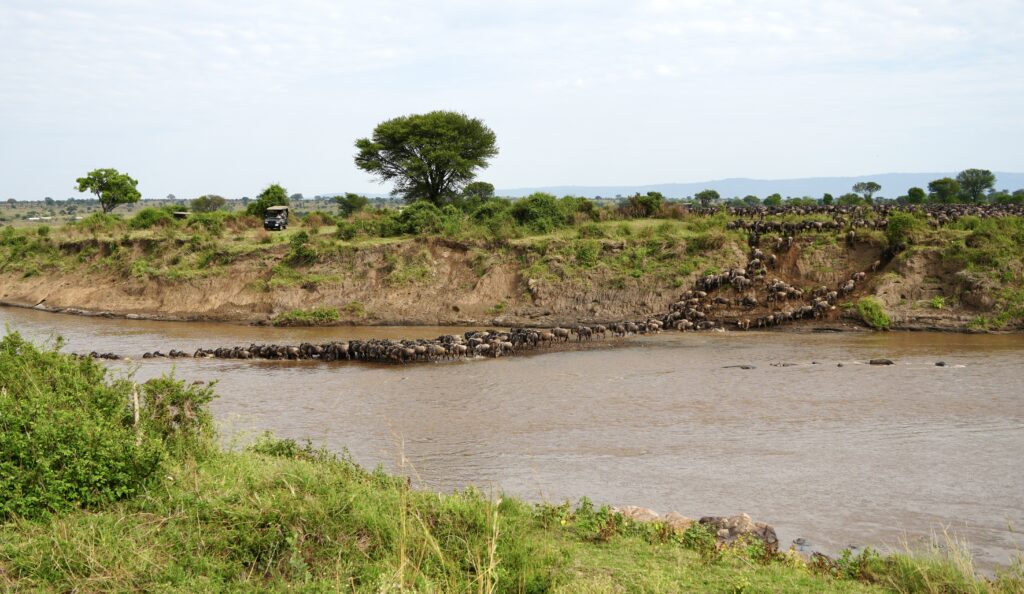

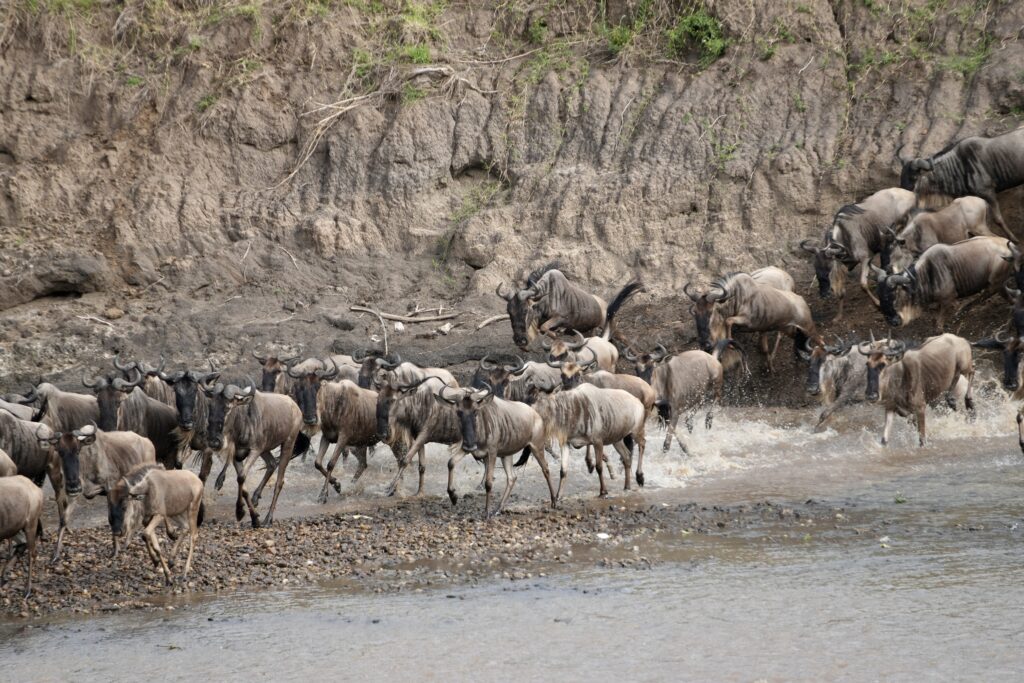
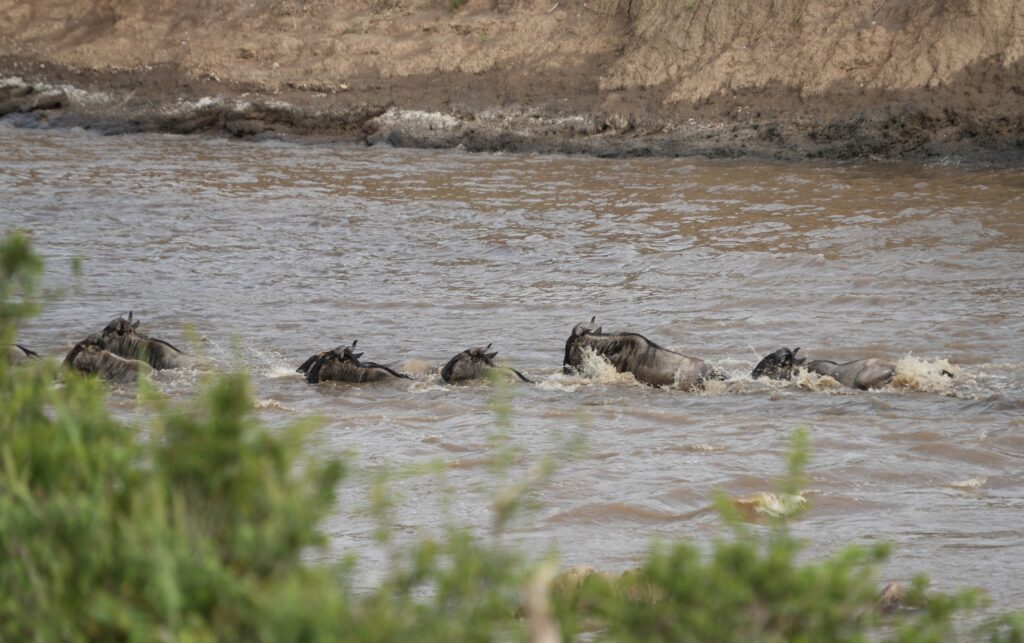
Driving away from the river, we discovered a flock of vultures fighting over a dead wildebeest. Snapping back and forth with their long necks, they are reminiscent of fictional dragon portrayals. It was easy to pick out the dominant bird who kept pushing the inferior vultures away.

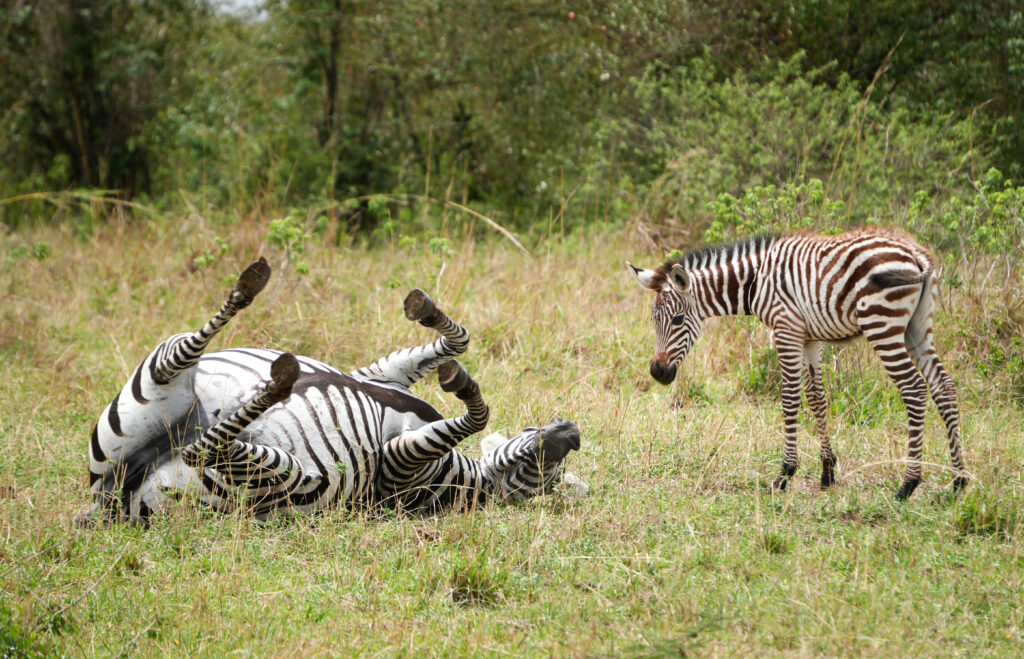
We took the rest of this day off, and evidently really needed the rest. We took almost a 3 hour nap, got up for just in time for dinner, and still slept well that night.
Day 5: Central Serengeti
On day five, we drove back to the Central Serengeti and did another game drive in this region. This day we had the incredible luck of watching a mating pair of lions. The act of mating takes less than a minute, after which the female will roll onto her back. Then they rest briefly before doing it all over again. I’ve read that they mate every 15-20 minutes. Our pair only took about a 5 minute break though before getting back into it.
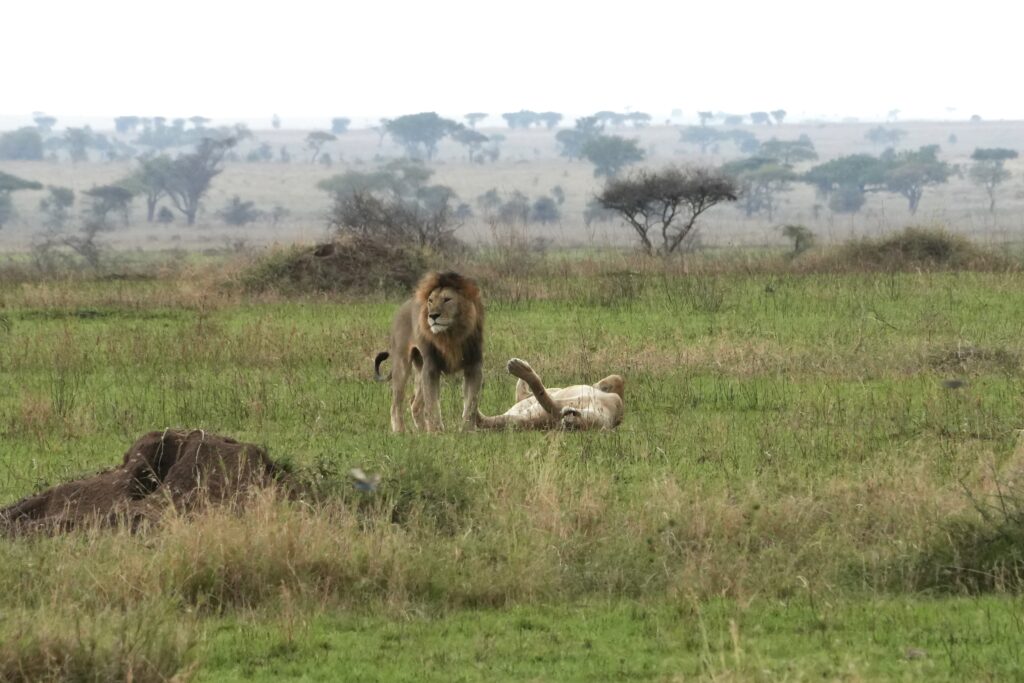
Some other unique sightings included our first serval cat sighting, a cheetah hiding in the brush, and a leopard walking across the savannah to climb a nearby tree. We also saw more hippos, zebras, and an unbelievable number of elephants across the flat plains.
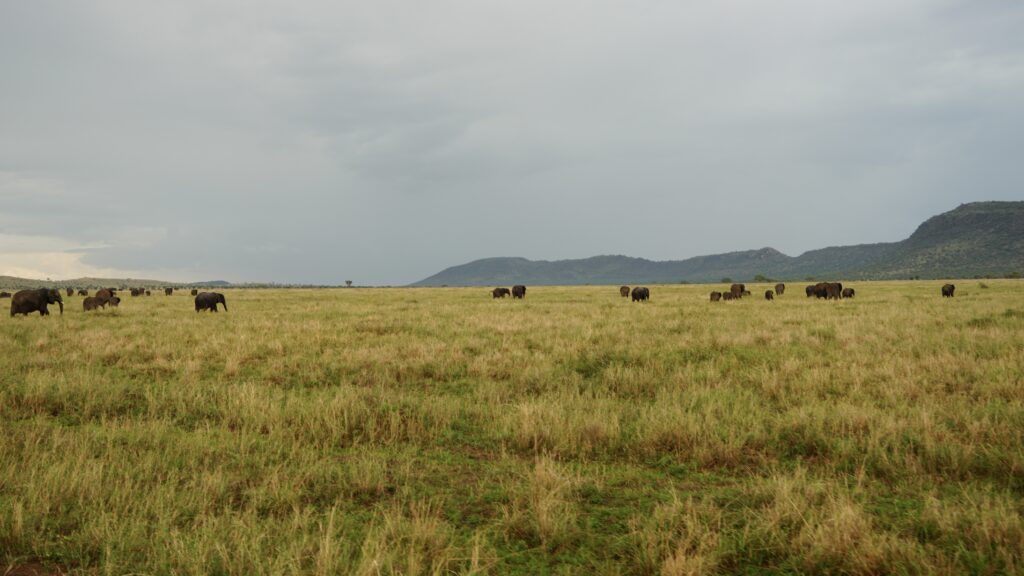

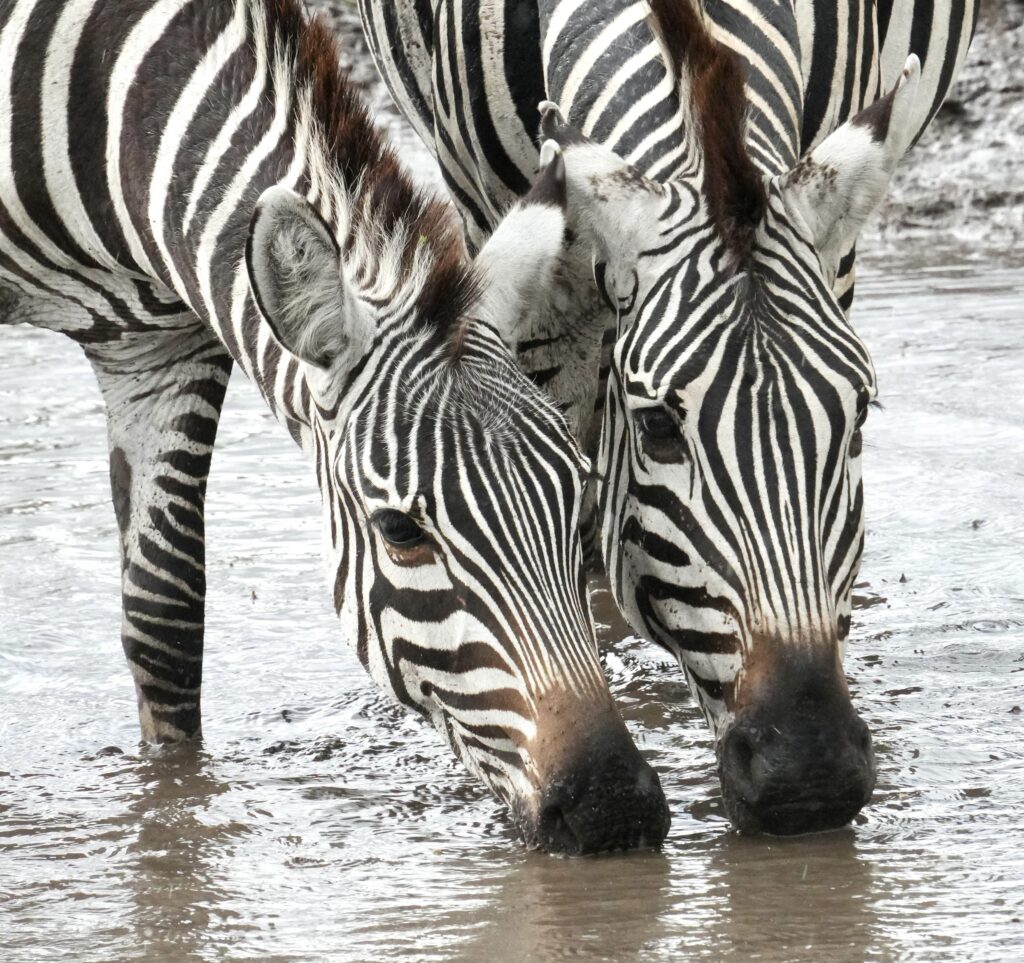
Our tented camp this night was really cool. With the patio tent door “open”, we could see through the netting, out past our wooden patio, to numerous zebra hanging out just 30 feet or so away. We even woke up in the early morning to their unique barking sounds.

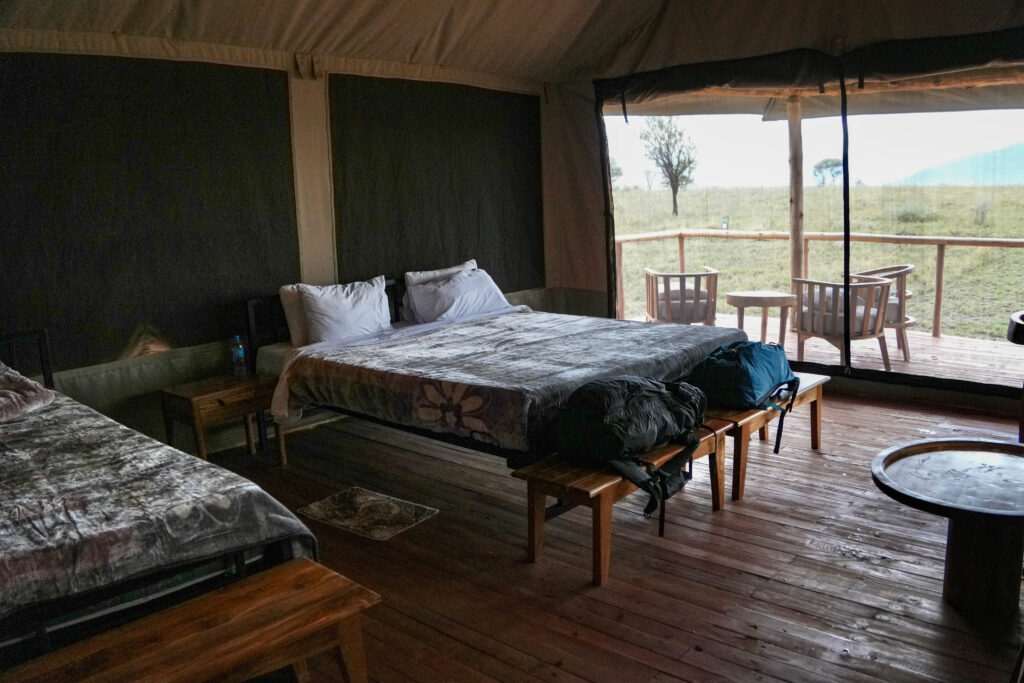
Day 6: Southern Serengeti
Day six included another morning game drive in the Serengeti, this time in the Southern Serengeti. The Southern Serengeti still had lots of wildlife, but a few less safari vehicles. One of the highlights of this game drive was finding two cheetah who were hunting together. We watched them prowling a herd of impala. They didn’t catch any while we were around though.

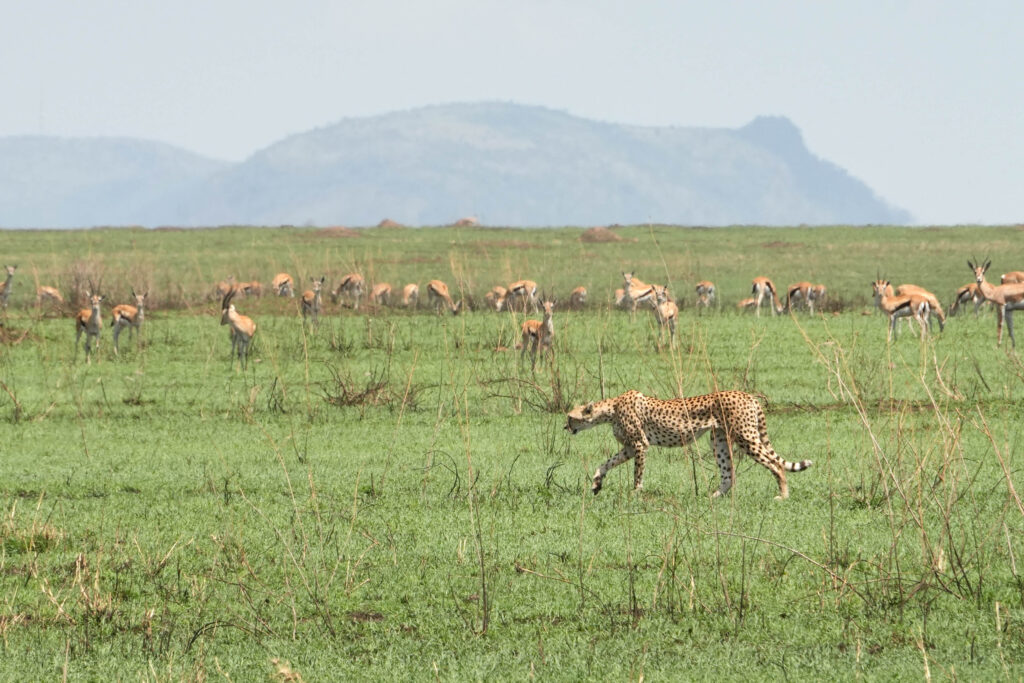
The other most exciting find was another leopard. This gorgeous cat was sitting in almost full view on a rock, awake and looking back at the tourists and their cameras. We watched her clean herself before getting up and showing us her powerful body.
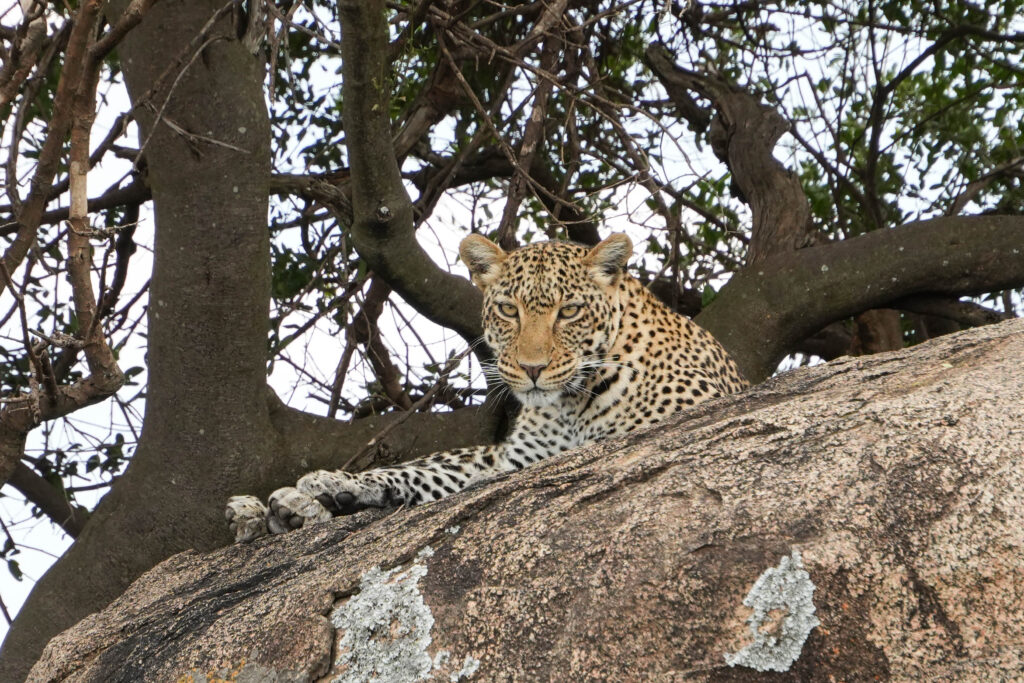
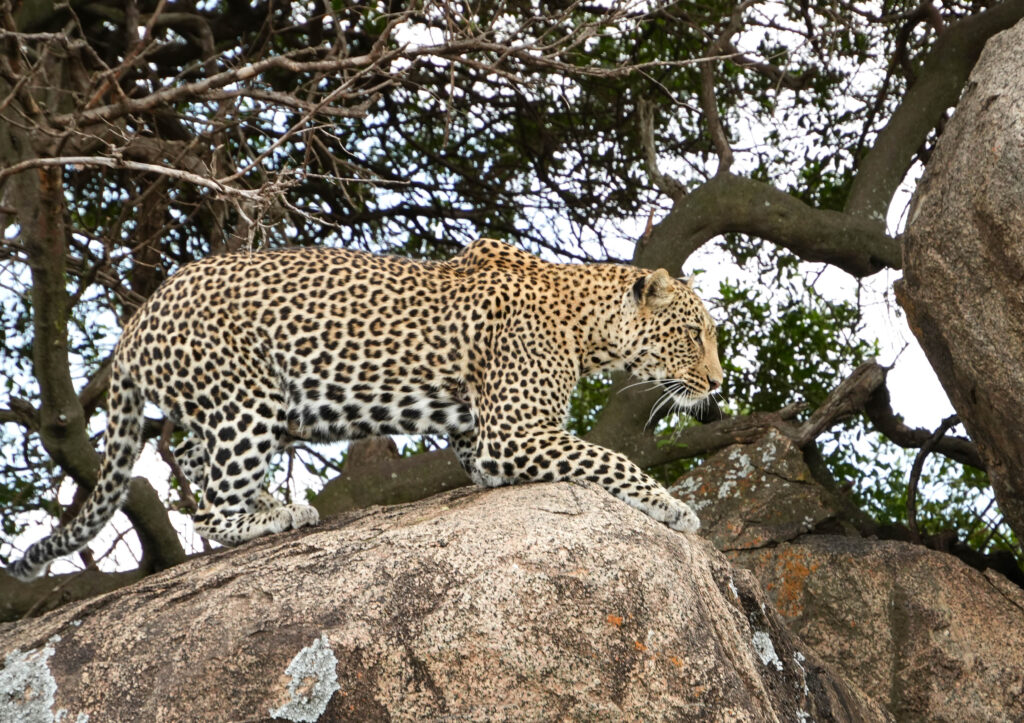
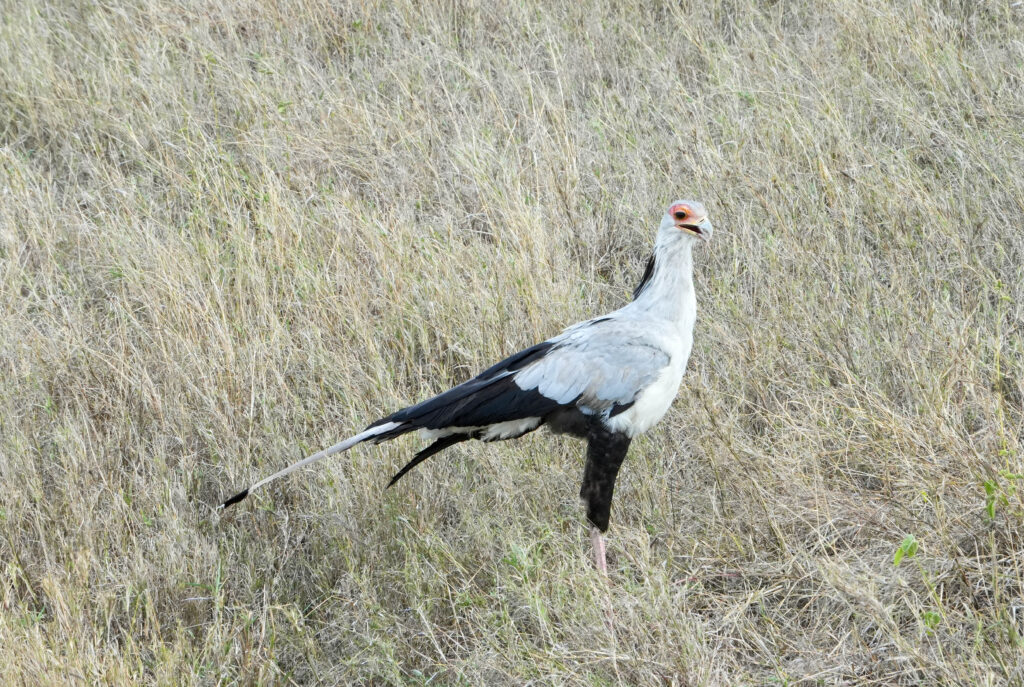
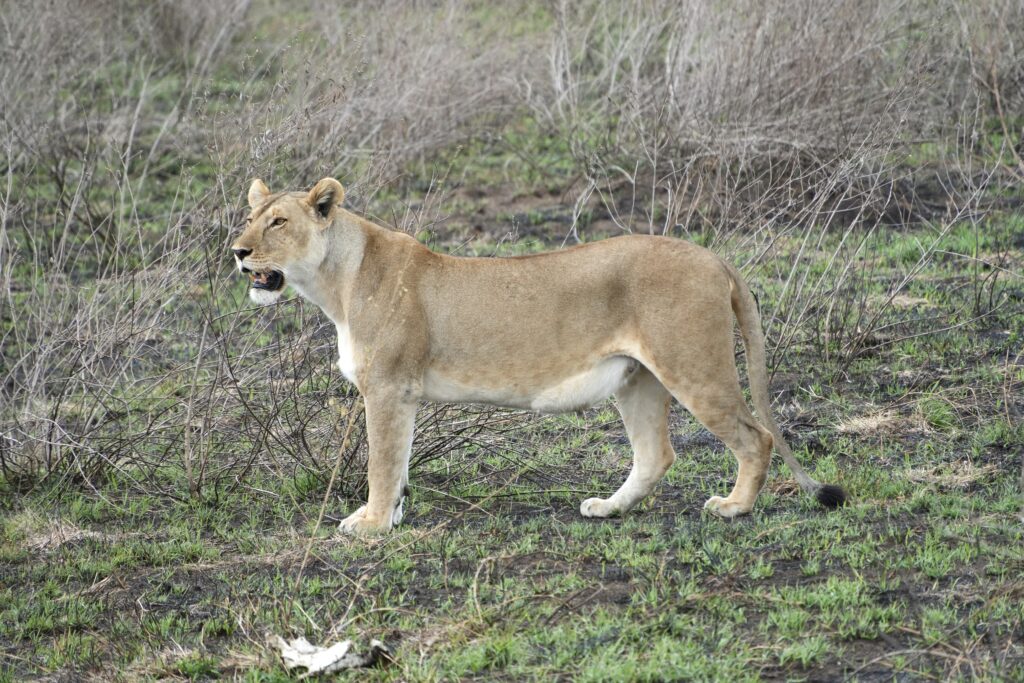
After hours of driving around the Southern Serengeti, we headed east to leave the park and continue to the Ngorogoro Crater Highlands to sleep. But the Serengeti wasn’t done with us yet and snared us in one of her mud filled roads. Another guide tried to help us, but also got stuck. Luckily a couple from Guadalajara, Mexico with great driving skills and a rope showed up and pulled both vehicles out.
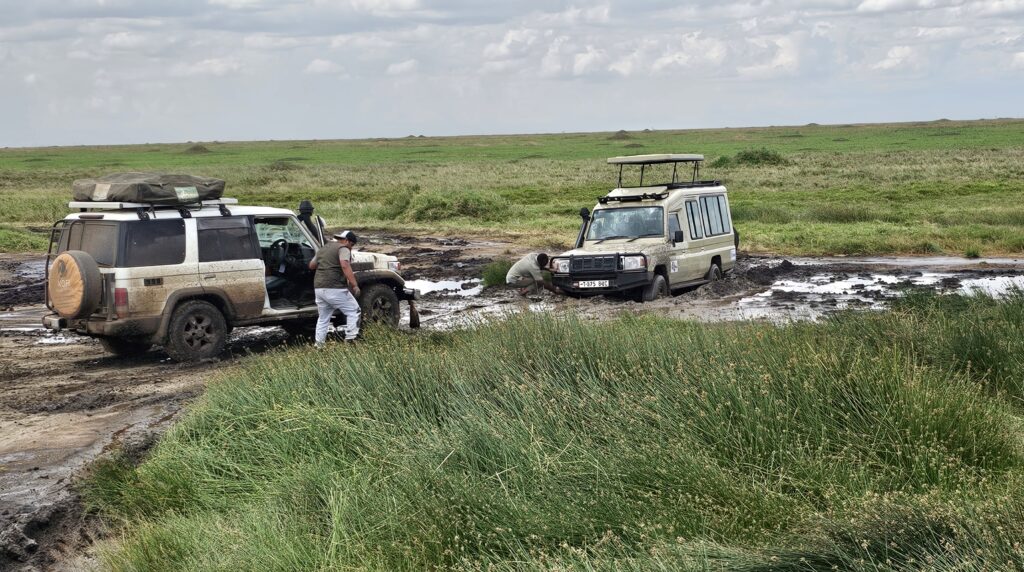
Enduring the drive back to the Ngorongoro Crater area was especially exhausting. I personally think doing this road twice is just too much. There was so much dust being kicked up by other vehicles, that we couldn’t even see the road right in front of us on multiple occasions. Dust started to cake the windshield and our guide repeatedly threw water out his window onto it to clear away the muck.
When we finally made it to Ngorongoro Wild Camp for the night, I was beyond excited for a shower to wash the gritty layer of dust from my face and hair.

Day 7: Ngorongoro Crater
This was our final safari day and we spent it at Ngorongoro Crater. Ngorongoro Crater is the world’s largest inactive, intact and unfilled volcanic caldera. The crater formed when a large volcano erupted and collapsed on itself two to three million years ago. We drove about an hour from our lodge to reach the gate. From here, it was just a short drive down from the gate at the top to the floor of the crater.
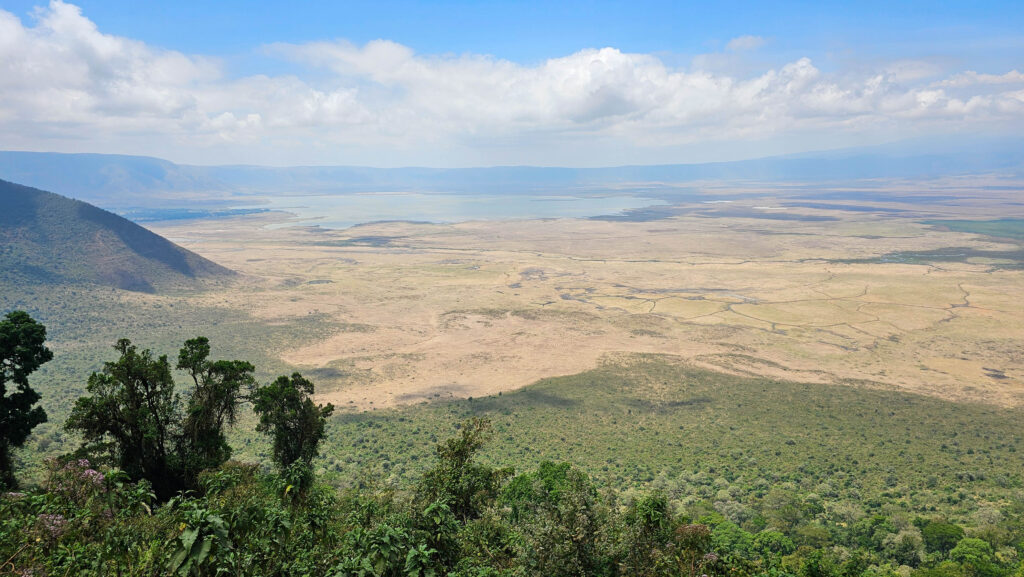
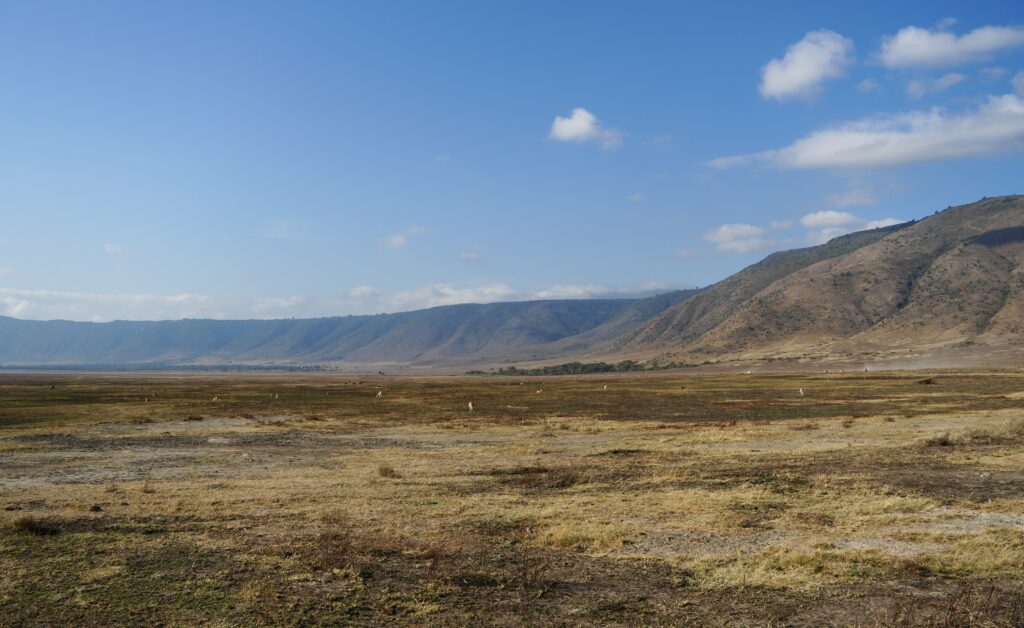
We explored the crater for about 5 hours. A few highlights we saw include another serval cat, a few warthogs, 2 female lions by a small pond, and a male/female pair of lions where the female laid down right next to our vehicle’s back tire. The crater was full of herds of zebra, wildebeest, water buffalo, gazelles, herds of impala, and lots of birds including storks. Ngorongoro Crater also gave us our first hyena sightings, the first of which was one feeding on a carcass while a small jackal waited nearby hoping for some leftovers.

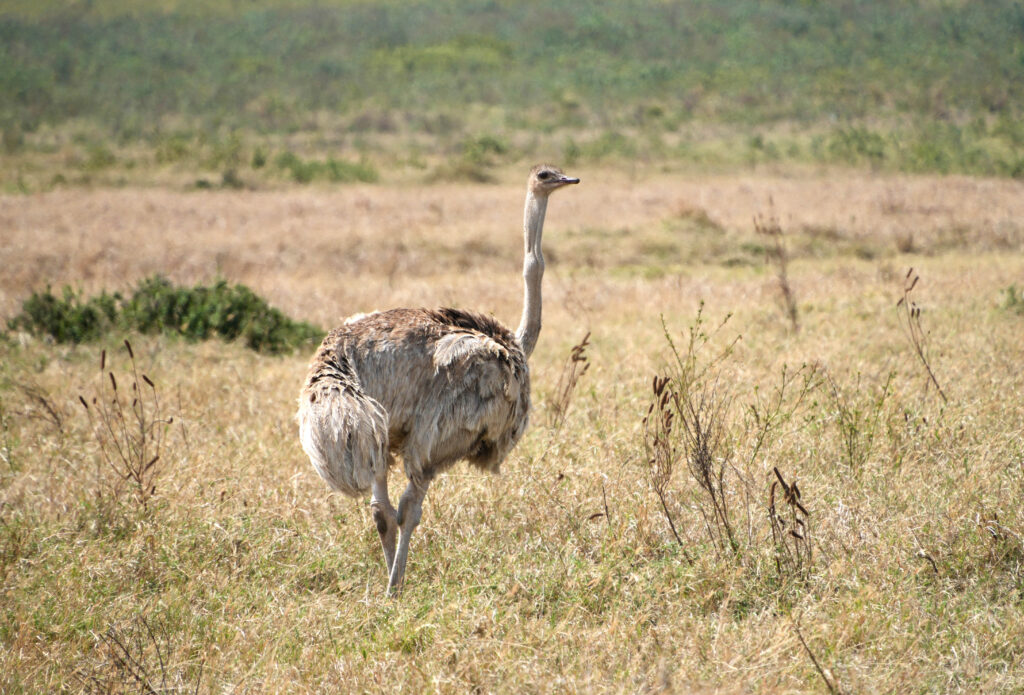
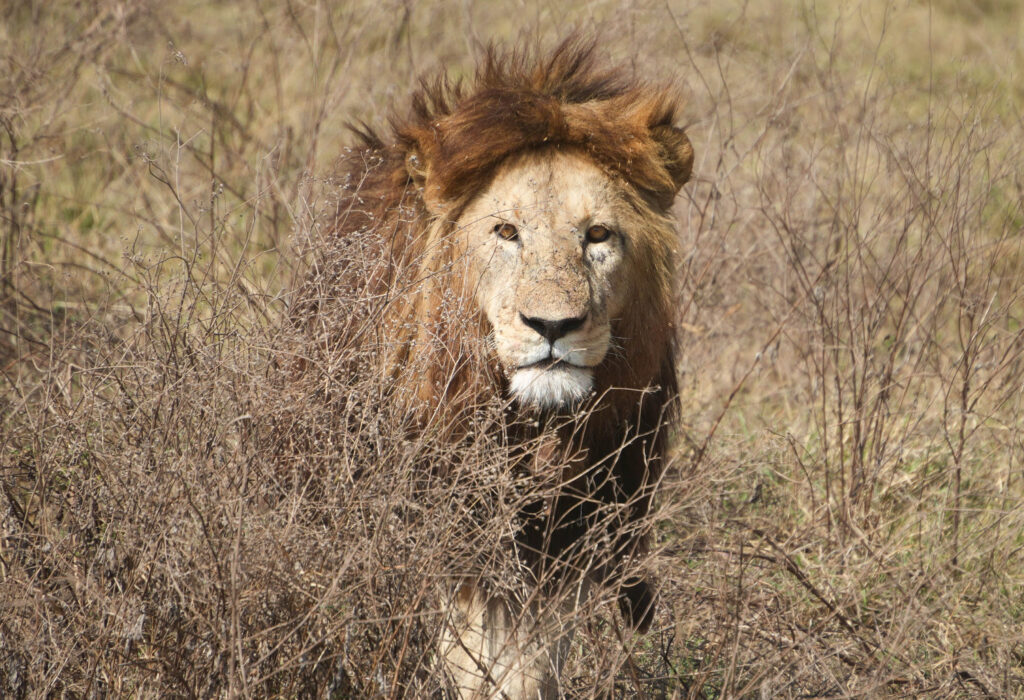
Seeing and driving down inside the crater was a cool experience. There are lots of animals that are easy to see due to the flat cleared land. There is even rhino in the crater, however our luck ran out and we did not find any.
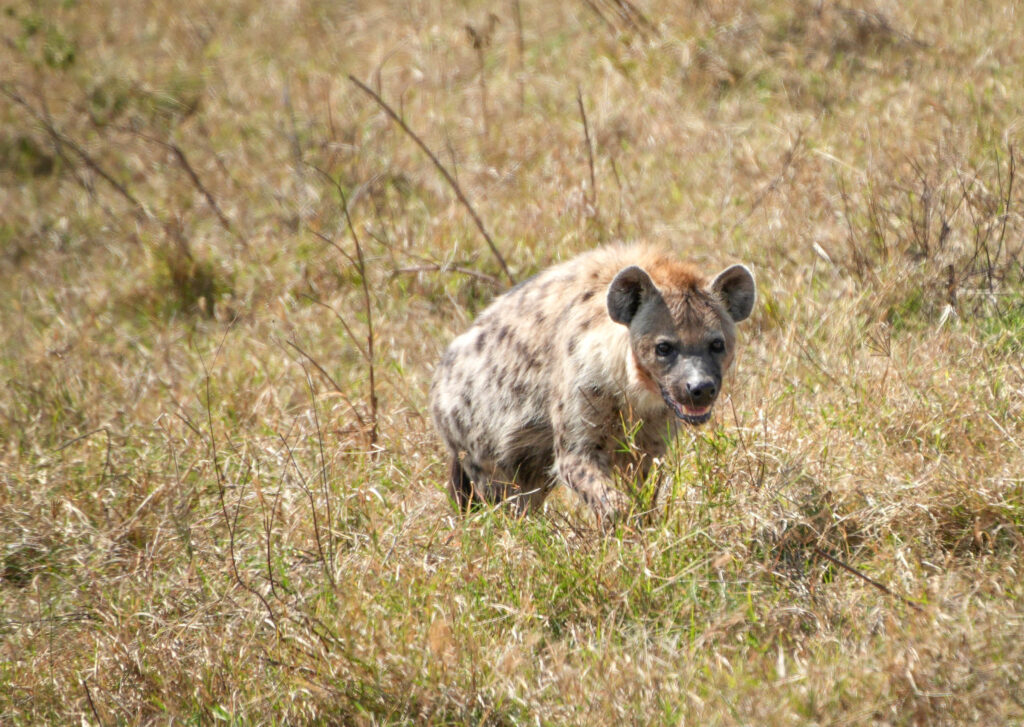
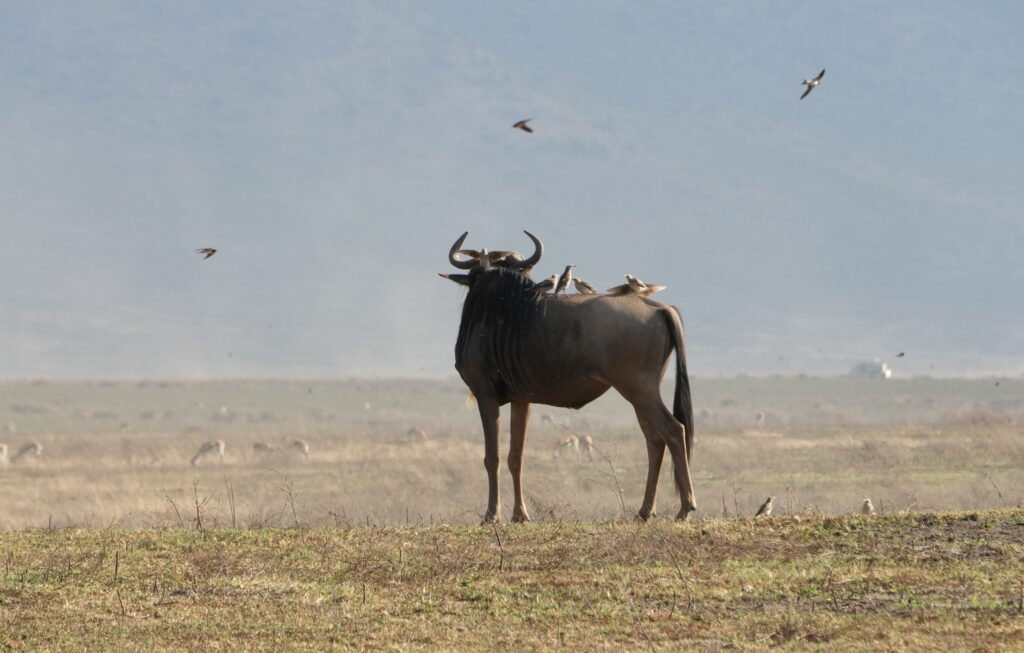

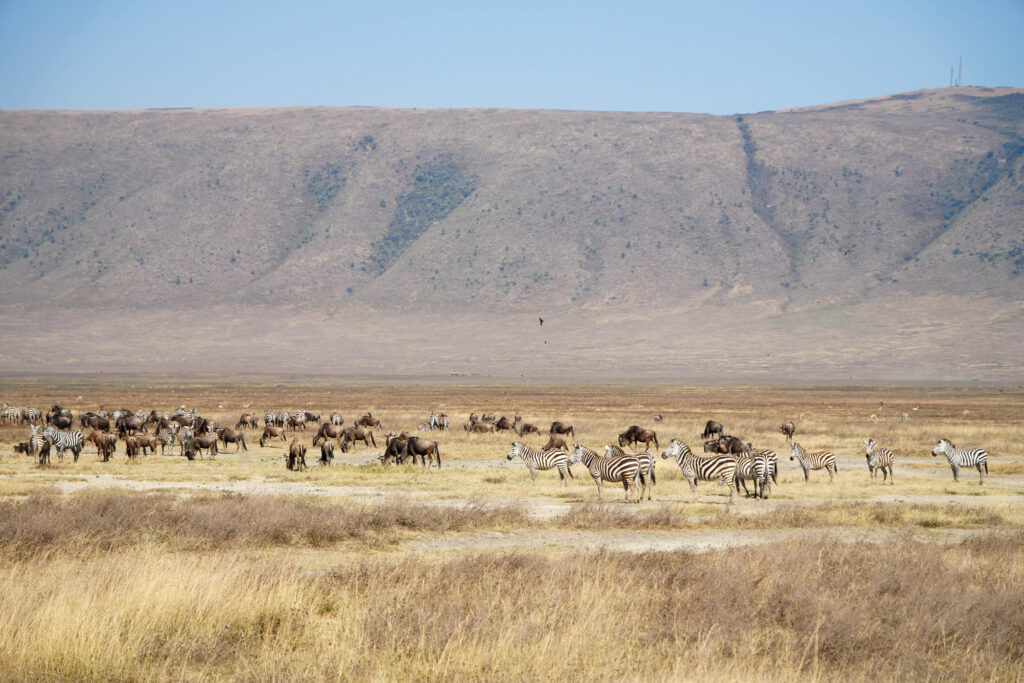
After we got back to the top of the crater, it was just a short 20 minute drive to our lodge. We stayed at Eileen’s Trees Inn. This place was lovely. The grounds are full of trees, flowers, and the sound of birds chirping. They have a really nice dining room, a fire pit, pool, and comfy rooms. We were really excited to just relax after all the time spent in a car during the last week and Eileen’s Trees Inn was just what we needed.
Day 8: Return to Arusha
Our final day had no safari, just a return drive to Arusha. We relaxed at our lodge until about 9 a.m. when our guide picked us up for the easy 3 hour drive on paved roads back to Arusha. Once back to the city, we had the rest of the day to relax.
Final thoughts:
Tanzania is an awesome destination to go on safari. There were multiple parks in a drivable distance, all with many animals. The guides are very skilled spotters and communicate with each other to find the best wildlife sightings. Most of the animals are use to the vehicles driving around and seem to hardly take notice of them.
All of the roads in the Serengeti are either gravel or dirt roads. They are quite rough, full of potholes created by rainstorms. If it hasn’t rained in a couple days, there will be plenty of dust here too. The experience in the Serengeti is well worth the rough dusty roads, just expect to get a little dirty each day.
If the road from the entrance of Ngorongoro Crater to the central Serengeti was improved, I would say our itinerary was awesome. With the road in the state that it currently is in, however, I may recommend something different. If we did it again, I would consider a flight into Serengeti at least one direction so that we wouldn’t have to do that drive twice. If you have a little less time, or just want to see lots of animals and are less interested in the crater itself, I would consider just flying in and out of the Serengeti and skipping the crater. It would be a much less exhausting experience to spend most nights at the same lodge, enjoy the abundance of wildlife in the Serengeti, and avoid this rough drive.
If you enjoyed reading about our safari in Tanzania, you may want to check out my blog about my trip to Kenya next.
This article beautifully recounts an unforgettable 8-day Tanzania safari, offering vivid descriptions of wildlife encounters and stunning landscapes in Serengeti, Ngorongoro Crater, and more. It highlights the seamless experience with Safari 360, making it a great resource for future safari travelers. Thank you for sharing!
Thanks for Sharing this Amazing and Informative Post